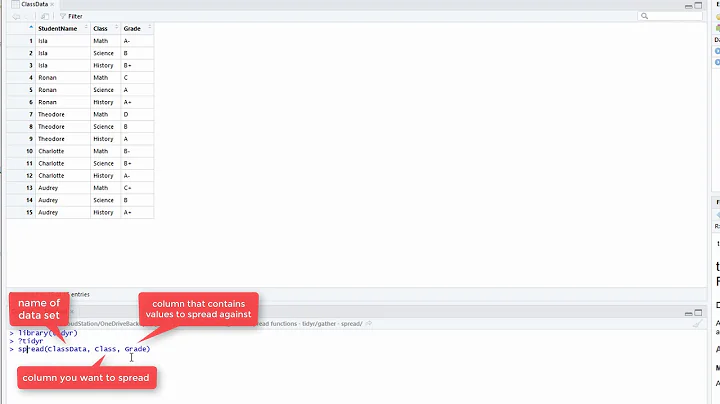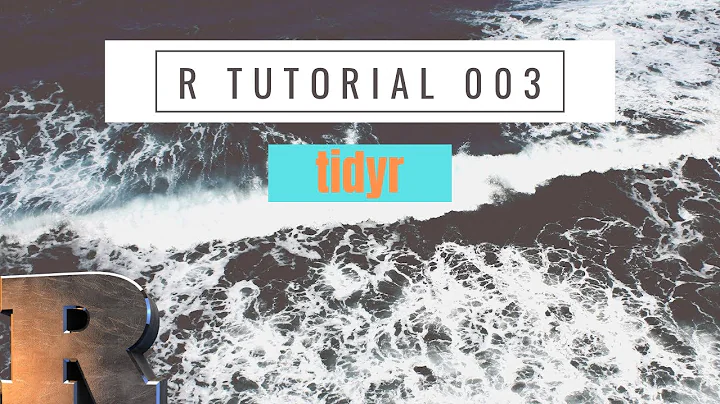How to Transpose (t) in the Tidyverse Using Tidyr
Solution 1
The general idiom in the tidyverse is to gather() your data to the maximal extent, forming a "long" data frame with one measurement per row. Then, spread() can revert this long data frame into whichever "wide" format that you like best. This procedure can effectively transpose the data: just gather() all the identifier columns except the row names, and then spread() the row names.
For example, here is how to effectively transpose mtcars:
require(tidyverse)
mtcars %>%
rownames_to_column %>%
gather(variable, value, -rowname) %>%
spread(rowname, value)
Your data does not have "row names" as understood in R, but Code1 effectively serves as a row name because it uniquely identifies each (original) row of your data.
Df1 <- Df %>%
group_by(Code1, Code2, Level) %>%
summarise_all(funs(count = sum(!is.na(.)))) %>%
gather(column, value, -Code1) %>%
spread(Code1, value)
UPDATE for tidyr 1.0 or higher (late 2019 onwards)
The new pivot_wider() and pivot_longer() functions are now preferred over the older (but still supported) gather() and spread(). Thus the preferred way to transpose mtcars is probably
require(tidyverse)
mtcars %>%
rownames_to_column() %>%
pivot_longer(-rowname, 'variable', 'value') %>%
pivot_wider(variable, rowname)
Solution 2
library(tidyr)
library(dplyr)
Df <- Df %>% group_by(Code1, Code2, Level) %>%
summarise_all(funs(count = sum(!is.na(.)))) %>%
gather(var, val, 2:ncol(Df)) %>%
spread(Code1, val)
Related videos on Youtube
Mike
Updated on June 11, 2022Comments
-
Mike almost 2 years
Using the sample data (bottom), I want to use the code below to group and summarise the data. After this, I want to transpose, but I'm stuck on how to use tidyr to achieve this?
For context, I'm attempting to recreate an existing table that was created in Excel using knitr::kable, so the final product of my code below is expected to break tidy principles.
For example:
library(tidyverse) Df <- Df %>% group_by(Code1, Code2, Level) %>% summarise_all(funs(count = sum(!is.na(.))))I can add t(.) using the pipe...
Df <- Df %>% group_by(Code1, Code2, Level) %>% summarise_all(funs(count = sum(!is.na(.)))) %>% t(.)or I can add...
Df <- as.data.frame(t(Df)Both of these options allow me to transpose, but I'm wondering if there's a tidyverse method of achieving this using tidyr's
gatherandspreadfunctions? I want to have more control over the process and also want to remove the "V1","V2", etc, that appear as column names when using transpose (t).How can I achieve this using tidyverse?
Sample Code:
Code1 <- c("H200","H350","H250","T400","T240","T600") Code2 <- c("4A","4A","4A","2B","2B","2B") Level <- c(1,2,3,1,2,3) Q1 <- c(30,40,40,50,60,80) Q2 <- c(50,30,50,40,80,30) Q3 <- c(30,45,70,42,81,34) Df <- data.frame(Code1, Code2, Level, Q1, Q2, Q3) -
 mx0 over 6 yearsWhile this code may answer the question, providing additional context regarding how and/or why it solves the problem would improve the answer's long-term value.
mx0 over 6 yearsWhile this code may answer the question, providing additional context regarding how and/or why it solves the problem would improve the answer's long-term value. -
 Earlien almost 3 yearsIf your data.frame or tibble has different data types, you may have to explicilty coerce them to a consistent data type first, e.g. using apply(mtcars, 2, as.character). Otherwise, pivot_longer may result in an error. (Works fine with mtcars, but might not in general).
Earlien almost 3 yearsIf your data.frame or tibble has different data types, you may have to explicilty coerce them to a consistent data type first, e.g. using apply(mtcars, 2, as.character). Otherwise, pivot_longer may result in an error. (Works fine with mtcars, but might not in general).










